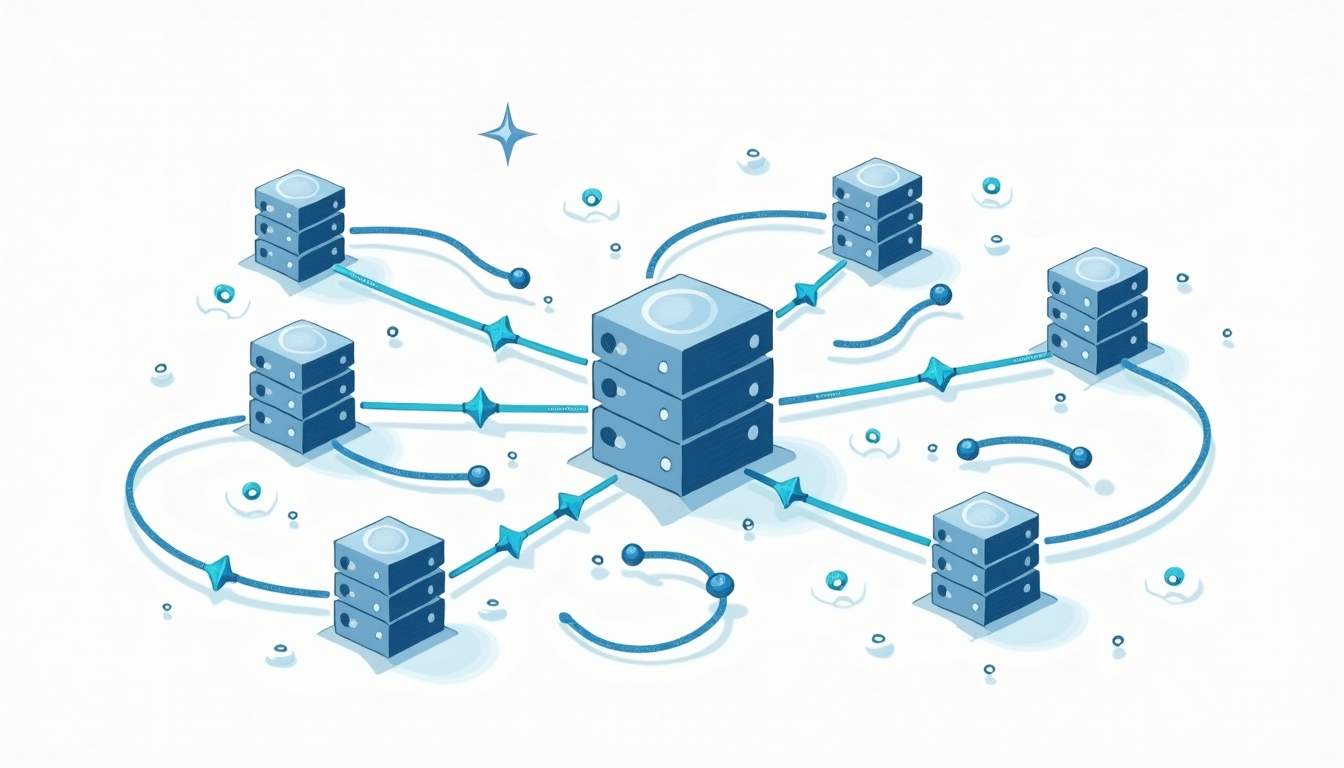Building Smarter RPC Load Balancers with LLM Feedback Loops
In the rapidly evolving world of Web3 and blockchain infrastructure, ensuring reliable and efficient Remote Procedure Call (RPC) routing is paramount. As decentralized applications (dApps) scale and user expectations for seamless interactions rise, the need for smarter RPC load balancers becomes critical. Leveraging Large Language Models (LLMs) for continuous feedback loops offers a groundbreaking approach to enhancing RPC load balancing, reducing downtime, and optimizing costs.
Understanding RPC Load Balancing in Blockchain
RPC load balancing refers to the process of distributing blockchain API requests across multiple RPC providers to ensure high availability, low latency, and fault tolerance. Unlike traditional centralized systems, blockchain applications rely heavily on RPC endpoints to interact with decentralized networks. When a single RPC provider experiences downtime or latency spikes, the entire dApp can suffer, leading to poor user experience and potential financial losses.
Traditional RPC load balancers typically use static algorithms such as round-robin or weighted distribution to route requests. While these methods provide basic redundancy, they often lack the adaptability to respond dynamically to real-time network conditions, provider outages, or fluctuating costs. This is where smarter, AI-driven load balancing becomes invaluable.
The Difference Between RPC Failover and Load Balancing
It’s important to distinguish between RPC failover and load balancing. Failover mechanisms switch all traffic to a backup RPC provider only when the primary provider fails, ensuring continuity but potentially causing latency spikes. Load balancing, on the other hand, distributes traffic across multiple providers simultaneously, optimizing resource utilization and reducing the risk of bottlenecks.
Smart RPC load balancers combine both strategies, dynamically adjusting traffic distribution based on real-time performance metrics, provider health, and cost considerations.
Introducing LLM Feedback Loops for Smarter Routing
Large Language Models (LLMs), such as GPT-4, have demonstrated remarkable capabilities in understanding complex patterns, generating insights, and automating decision-making processes. Integrating LLMs into RPC load balancers enables the creation of feedback loops that continuously analyze RPC performance data, user behavior, and network conditions to optimize routing strategies.
How LLMs Enhance RPC Load Balancing
LLMs can process vast amounts of telemetry data from multiple RPC endpoints, including latency, error rates, throughput, and cost metrics. By analyzing this data, LLMs can predict potential outages, identify underperforming providers, and recommend optimal routing adjustments in near real-time. This proactive approach minimizes downtime and enhances the overall reliability of blockchain applications.
Moreover, LLMs can incorporate external factors such as network congestion trends, gas price fluctuations, and regional traffic patterns to fine-tune routing decisions. This level of contextual awareness is difficult to achieve with traditional load balancers.
Feedback Loop Architecture
A typical LLM feedback loop for RPC load balancing involves several key components:
- Data Collection: Continuous monitoring of RPC endpoints for performance metrics and error logs.
- LLM Analysis: The LLM ingests the collected data, applies predictive analytics, and generates routing recommendations.
- Routing Adjustment: The load balancer updates traffic distribution based on LLM insights.
- Outcome Monitoring: The system evaluates the impact of routing changes and feeds this information back to the LLM for further refinement.
This cyclical process ensures that the load balancer evolves with the network, adapting to new challenges and optimizing resource allocation continuously.
Benefits of LLM-Driven RPC Load Balancers
Integrating LLM feedback loops into RPC load balancers offers several compelling advantages for blockchain developers and infrastructure providers.
1. Improved Reliability and Reduced Downtime
RPC downtime can severely impact blockchain projects by disrupting transactions, slowing dApp responsiveness, and eroding user trust. According to industry analyses, even brief RPC outages can cost projects thousands of dollars in lost revenue and user engagement. LLM-driven load balancers proactively detect early warning signs of failures and reroute traffic before users experience issues, significantly reducing downtime.
2. Cost Optimization
Running RPC calls through multiple providers can be expensive, especially for high-volume dApps. LLMs can analyze cost-performance trade-offs across providers and dynamically allocate traffic to the most cost-effective endpoints without compromising quality. This approach has been shown to reduce RPC costs by up to 40%, a crucial saving for startups and projects scaling to millions of API calls.
3. Enhanced Latency and User Experience
Latency is a critical factor in blockchain interactions. Multi-region RPC routing, combined with LLM insights, allows load balancers to direct traffic to the closest or fastest-performing endpoints. This reduces response times and creates a smoother user experience, which is essential for real-time applications like gaming, DeFi, and NFT marketplaces.
4. Multi-Provider Redundancy
Relying on a single RPC provider introduces significant risks, including vendor lock-in and single points of failure. LLM-enhanced load balancers facilitate seamless multi-provider integration, automatically switching between providers based on performance metrics and network conditions. This multi-provider redundancy is increasingly recognized as the future of Web3 infrastructure.
Implementing LLM Feedback Loops: Practical Considerations
While the concept of LLM-driven RPC load balancing is promising, practical implementation requires careful planning and expertise.
Data Quality and Monitoring
Effective feedback loops depend on high-quality, granular data from RPC endpoints. Developers must implement robust monitoring tools to capture latency, error rates, throughput, and regional performance metrics. Integrating these data streams into a centralized analytics platform enables the LLM to generate accurate and actionable insights.
Model Training and Customization
LLMs need to be fine-tuned with domain-specific knowledge about blockchain networks, RPC protocols, and provider characteristics. Custom training datasets that reflect the unique behaviors of different blockchains (Ethereum, Solana, Polygon, etc.) improve the model’s predictive accuracy and routing recommendations.
Latency of Decision-Making
Load balancing decisions must occur in near real-time to be effective. The LLM inference process should be optimized for low latency, potentially using edge computing or lightweight model variants. Balancing model complexity with response speed is critical to maintaining system performance.
Security and Privacy
RPC endpoints often handle sensitive transaction data. Ensuring that LLM feedback loops do not expose or mishandle this data is essential. Secure data pipelines and compliance with privacy standards must be integral to the system design.
Future Trends: From RPC to Multi-Cloud Proxy (MCP) Integration
The evolution of blockchain infrastructure is moving beyond traditional RPC providers toward multi-cloud and multi-region architectures. Google’s Multi-Cloud Proxy (MCP) technology exemplifies this trend by enabling seamless API orchestration across multiple cloud providers, enhancing scalability and reliability.
Integrating LLM-driven RPC load balancers with MCP frameworks can further enhance Web3 application performance. By orchestrating API calls across diverse cloud environments and blockchain networks, developers can achieve unprecedented levels of redundancy, latency reduction, and cost efficiency.
As blockchain projects scale globally, the combination of LLM feedback loops and multi-cloud RPC routing will become a standard for ensuring resilient and performant infrastructure.
Conclusion
Building smarter RPC load balancers with LLM feedback loops represents a significant leap forward in blockchain infrastructure management. By harnessing the analytical power of large language models, developers can create adaptive, cost-efficient, and highly reliable RPC routing solutions that meet the demands of modern Web3 applications.
This approach not only mitigates the risks associated with RPC downtime and single-provider dependence but also optimizes latency and operational costs. As the blockchain ecosystem continues to grow, embracing AI-driven load balancing and multi-cloud integration will be essential for projects aiming to deliver seamless, scalable, and secure user experiences.
Ready to elevate your Web3 project with the cutting-edge infrastructure described in this article? Look no further than Uniblock, the Web3 infrastructure orchestration platform trusted by over 2,000 developers. With Uniblock, you'll enjoy seamless connectivity to blockchain data through a single API endpoint, ensuring maximum uptime, minimal latency, and significant cost savings. Say goodbye to vendor lock-in and scale your dApps, tooling, or analytics with confidence. Start building with Uniblock today and join a community dedicated to simplifying decentralized infrastructure management.
.svg)






